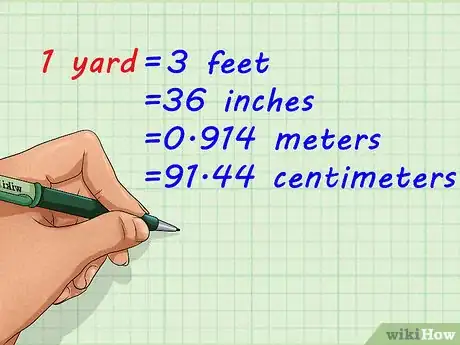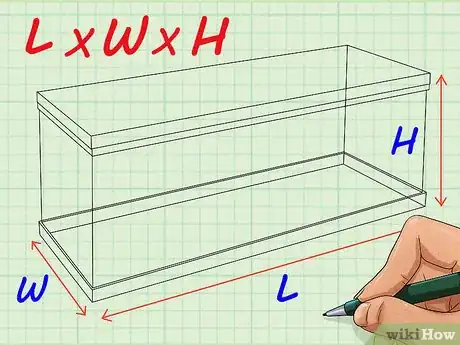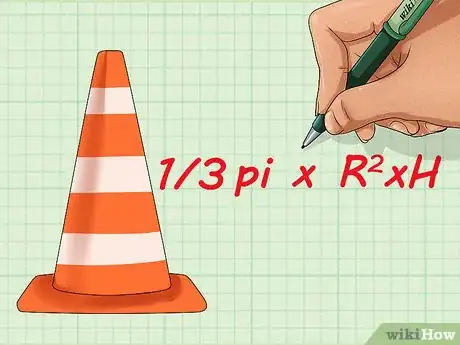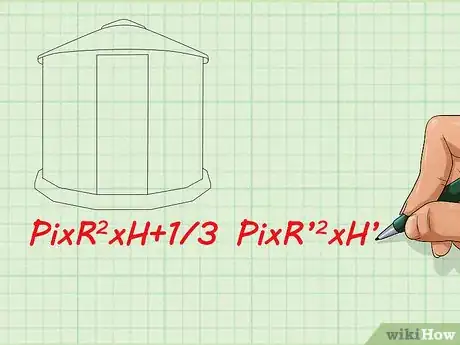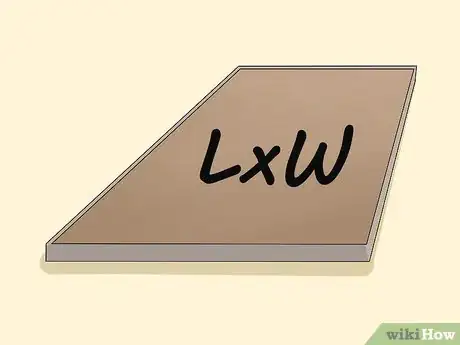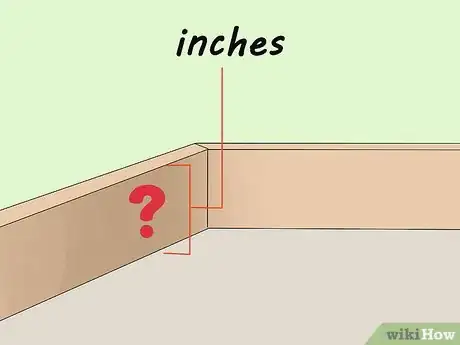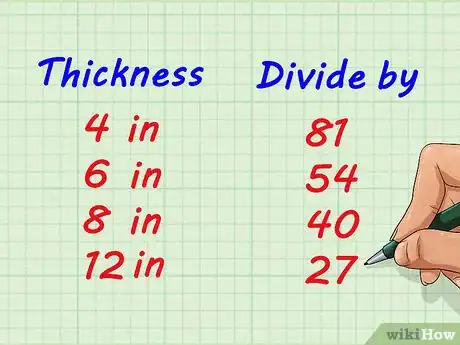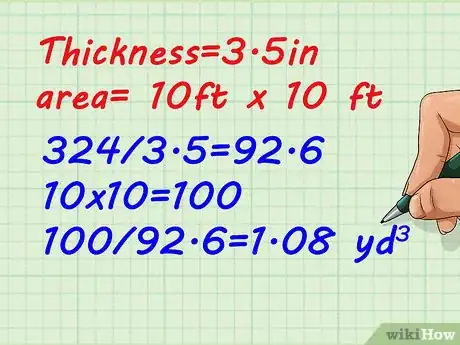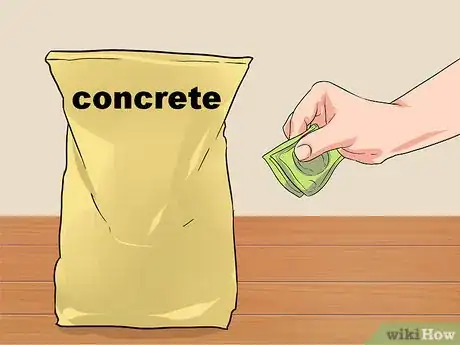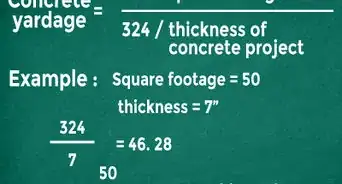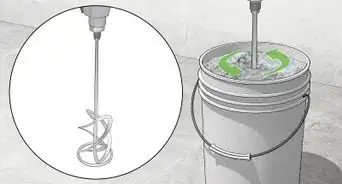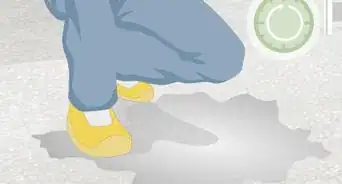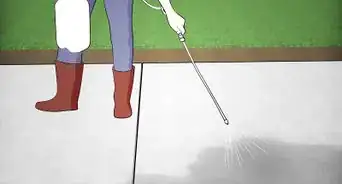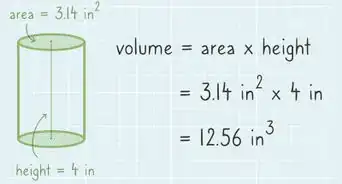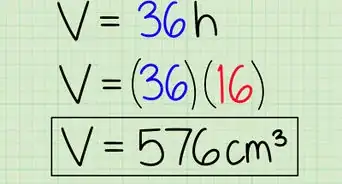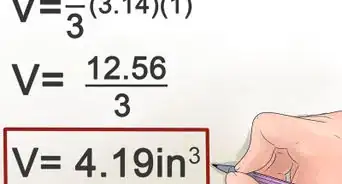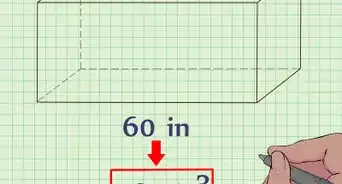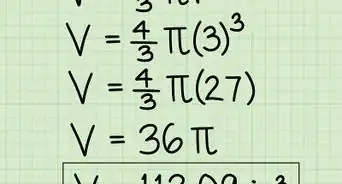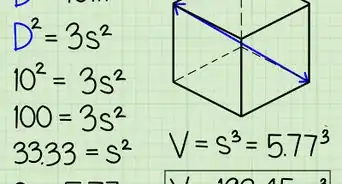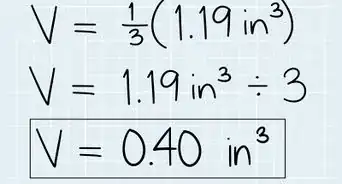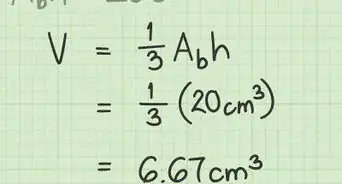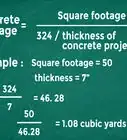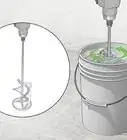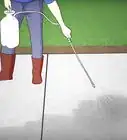wikiHow is a “wiki,” similar to Wikipedia, which means that many of our articles are co-written by multiple authors. To create this article, 14 people, some anonymous, worked to edit and improve it over time.
This article has been viewed 69,893 times.
Learn more...
Cubic yards (abbreviated "yd3" or "cu yd")are a unit of volume measurement equal to the volume of a cube whose sides are exactly one yard in length or about 764.5 liters (202.0 US gal). Cubic yards are the preferred units of measurement for a variety of practical tasks and activities - for instance, when pouring concrete during a construction project. For a given rectangular space with length "L", width "W", and height "H", a volume in cubic yards can be simply obtained via the equation Volume = L × W × H, provided L, W, and H are all measured in yards.
Steps
Determining Volume for 3-D Spaces
-
1Obtain all necessary measurements in yards. Cubic yard volumes can be obtained relatively easily for a variety of standard three-dimensional spaces via a few simple equations. However, these equations assume that all measurements have been taken in yards. Thus, before using one of these equations, it's important to ensure that you took your initial measurement(s) in yards or, alternatively, that you converted them into yards via a conversion factor. A few conversions for common measurements of length are below:
- 1 yard = 3 feet
- 1 yard = 36 inches
- 1 yard = 0.914 meters
- 1 yard = 91.44 centimeters
-
2Use the equation L × W × H for rectangular spaces. The volume of any rectangular three-dimensional space (rectangular prism, cuboid, etc.), can be determined simply by multiplying its length times its width times its height. This equation can also be thought of as multiplying the surface area of one of the rectangular space's faces by the dimension perpendicular to that face.
- For example, let's say we want to determine the volume (in yd3) of the dining room in our house. We measure the dining room to be 4 yd long, 3 yd wide, and 2.5 yd high. To determine the room's volume, we simply multiply its length, width, and height:
- 4 × 3 × 2.5
- = 12 × 2.5
- = 30. The room has a volume of 30 yd3.
- Cubes are rectangular spaces where all sides are equal in length. Thus, a cube's volume equation can be shortened from L × W × H to L3, etc.
Advertisement - For example, let's say we want to determine the volume (in yd3) of the dining room in our house. We measure the dining room to be 4 yd long, 3 yd wide, and 2.5 yd high. To determine the room's volume, we simply multiply its length, width, and height:
-
3For cylindrical spaces, use the equation pi × R2 × H. Finding the volume of a cylindrical space is simply a matter of multiplying the two-dimensional area of one of its circular faces by the height or length of the cylinder. Find the area of its circular face via the area equation for circles: multiply the mathematical constant pi (3.1415926...) by the circle's radius (the distance from the center of the circle to one of its edges) times itself. Then, simply multiply this answer by the height of the cylinder to find the cylinder's volume. As always, ensure all values are in yards.
- For example, let's say we want to determine the volume of a cylindrical hole in our back patio before installing a fountain. The hole is 1.5 yards across and 1 yard deep. Divide the distance across the hole in half to get the hole's radius: 0.75 yards. Then, multiply your variables according to the cylindrical volume equation:
- (3.14159) × 0.752 × 1
- = (3.14159) × 0.5625 × 1
- = 1.767. The hole has a volume of 1.767 yd3.
- For example, let's say we want to determine the volume of a cylindrical hole in our back patio before installing a fountain. The hole is 1.5 yards across and 1 yard deep. Divide the distance across the hole in half to get the hole's radius: 0.75 yards. Then, multiply your variables according to the cylindrical volume equation:
-
4For spheres, use the equation 4/3 pi × R3. To calculate the volume of a sphere in cubic yards, all you need to know is its radius - the distance from its center to its outside edge - in yards. Simply cube this number (multiply it by itself two times), then multiply it by 4/3 pi to get the sphere's volume in cubic yards.
- For example, let's say we want to find the volume inside a spherical hot air balloon. The hot air balloon is 10 yards across. Divide 10 in half to find the balloon's radius - 5 yards. Then, simply plug this into the equation for "R" as follows:
- 4/3 pi × (5)3
- = 4/3 (3.14159) × 125
- = 4.189 × 125
- = 523.6. There are 523.6 yd3 in the balloon.
- For example, let's say we want to find the volume inside a spherical hot air balloon. The hot air balloon is 10 yards across. Divide 10 in half to find the balloon's radius - 5 yards. Then, simply plug this into the equation for "R" as follows:
-
5For cones, use the equation 1/3 pi × R2 × H. The volume of a given cone is 1/3 the volume of a cylinder that has the same height and radius as the cone. Simply find the height and radius of a cone (in yards), then solve as if finding the volume of a cylinder. Multiply your result by 1/3 to get the volume of your cone.
- For example, let's say that we want to find the volume of an ice cream cone. The ice cream cone is fairly small - it has a radius of 1 inch and a height of 5 inches. Converted to yards, these are .028 yards and .139 yards, respectively. Solve as follows:
- 1/3 (3.14159) × .0282 × .139
- = 1/3 (3.14159) × 0.000784 × .139
- = 1/3 × 0.000342
- = 1.141-4. There are 1.141-4 yd3 in the ice cream cone.
- For example, let's say that we want to find the volume of an ice cream cone. The ice cream cone is fairly small - it has a radius of 1 inch and a height of 5 inches. Converted to yards, these are .028 yards and .139 yards, respectively. Solve as follows:
-
6For irregular shapes, try using multiple equations. When confronted with a three-dimensional shape that doesn't have an elegant equation for its volume, try to break the space up into multiple spaces whose volume (in cubic yards) can be more easily calculated. Then, find the volume of these spaces individually, adding your results to find the final volume value.
- Let's say, for instance, that we want to find the volume of a small grain silo. The silo has a cylindrical body 12 yards high with a radius of 1.5 yards. The silo also has a conic roof that is 1 yard high. By calculating the volume of the roof and the body of the silo separately, we can find the silo's total volume:
- Pi × R2 × H + 1/3 Pi × R'2 × H'
- (3.14159) × 1.52 × 12 + 1/3 (3.14159) × 1.52 × 1
- = (3.14159) × 2.25 × 12 + 1/3 (3.14159) × 2.25 × 1
- = (3.14159) × 27 + 1/3 (3.14159) × 2.25
- = 84.822 + 2.356
- = 87.178. The silo has a volume of 87.178 cubic yards.
- Let's say, for instance, that we want to find the volume of a small grain silo. The silo has a cylindrical body 12 yards high with a radius of 1.5 yards. The silo also has a conic roof that is 1 yard high. By calculating the volume of the roof and the body of the silo separately, we can find the silo's total volume:
Quick Trick for Determining Concrete Yardage
-
1Find the square footage of the area where you're pouring. When pouring concrete to, for instance, make a concrete patio, you're usually pouring concrete into a mold several inches to a foot thick. In this case, it's not necessary to use relatively complex formulas to determine the volume of concrete you'll need. Instead, use a contractor's trick to quickly figure the amount of concrete you need. Begin by finding the square footage of the area you're pouring into.
- Remember - for square footage, we take our measurements in feet, not in yards, as above.
- As a reminder, for squares or rectangles, this area can be found by multiplying Length × Width. For circles, it's Pi × R2. For more complex shapes, browse wikiHow's many surface-area calculation guides.
-
2Find how thick your concrete must be. This is simple - just measure the depth of the mold you're pouring into. Because we're pouring into a relatively shallow mold, we can take our measurements in inches, rather than having to measure in unwieldy fractions of a foot.
-
3Divide your square footage by a coefficient based on the thickness of your concrete. All you need to do to determine your concrete yardage is to divide your number for square footage by a certain number - if your concrete needs to be thin, this number will be bigger. If your concrete needs to be thick, this number will be smaller. See below for common thicknesses, or proceed to the next step if your thickness doesn't match one of these:
- If the concrete is 4 inches thick, divide the square footage by 81 to determine cubic yards.
- If the concrete is 6 inches thick, divide the square footage by 54 to determine cubic yards.
- If the concrete is 8 inches thick, divide the square footage by 40 to determine cubic yards.
- If the concrete is 12 inches thick, divide the square footage by 27 to determine cubic yards.
-
4Determine odd thicknesses via simple formula. If you have a thickness that doesn't match any of the above examples, don't worry - it's easy to find the amount you need. Simply divide 324 over the thickness of your concrete (in inches). Then, multiply the answer by your square footage to determine the total concrete yardage.
- Let's say our concrete for a 10 ft × 10 ft area needs to be 3.5 inches thick. In this case, we would find our yardage as follows:
- 324/3.5 = 92.6
- 10 × 10 = 100
- 100/92.6 = 1.08. We need 1.08 yd3 concrete.
- Let's say our concrete for a 10 ft × 10 ft area needs to be 3.5 inches thick. In this case, we would find our yardage as follows:
-
5Buy a little more concrete than you need. When pouring concrete, it's usually a good idea to buy a little extra just in case your measurements weren't exact. After all,dry concrete mix that you don't end up using can be saved and used for another project. However, if you don't have enough, you're in a bind - someone may have to run to the hardware store before you can continue. So, be sure to buy a little extra, especially for large projects.
Community Q&A
-
QuestionHow can I determine how many cubic yards are in a pile of dirt?
 DonaganTop AnswererMeasure length, width, and height in yards. Estimate if you have to. Multiply the three together to get the volume.
DonaganTop AnswererMeasure length, width, and height in yards. Estimate if you have to. Multiply the three together to get the volume. -
QuestionHow do you calculate square yards in a triangular prism?
 Community AnswerTake the square feet of the area in question, multiply by the depth and then divide by 27. So, if you have a lot that is 50' x 60' in size and you want to add 4" of topsoil for new sod, you would multiply 50*60= 300 sq. ft, and then multiply by .33 (decimal conversion for 4") 300*.33=99.90 cubic feet, then divide by 27 to convert to cubic yards, so: 99.90/27=3.7 cu yd.
Community AnswerTake the square feet of the area in question, multiply by the depth and then divide by 27. So, if you have a lot that is 50' x 60' in size and you want to add 4" of topsoil for new sod, you would multiply 50*60= 300 sq. ft, and then multiply by .33 (decimal conversion for 4") 300*.33=99.90 cubic feet, then divide by 27 to convert to cubic yards, so: 99.90/27=3.7 cu yd. -
QuestionHow do I calculate the cubic yards of an irregularly-shaped large stone?
 DonaganTop AnswererIf the stone is too large to perform a water-displacement measurement on it, you can only estimate the volume.
DonaganTop AnswererIf the stone is too large to perform a water-displacement measurement on it, you can only estimate the volume.
About This Article
To determine cubic yards for pouring concrete, start by finding the square footage of the area you'll be filling in. If the area is square or rectangular, you can find the square footage by multiplying the length by the width. Once you have the square footage, measure how deep the mold you're filling in is. Finally, divide 324 by the depth of the mold and then multiply that number by the square footage to find out how many cubic yards you need. If you want to learn how to find cubic yards for a 3-D space, keep reading the article!
